Rinny reflects on 3rd Kona win
Now that the tumult and the shouting are over, Rinny Carfrae the mighty mite stands tall astride the Ironman realm. At age 33, she stands 5 feet 3 and ½ inches tall and weighs a power packed 115 pounds. But do not let that relatively modest stature fool you. Her strongest assets are first of all her will and then, perhaps in a tie, are her flying feet. Right now she has won three Ironman World championship titles and stands behind Paula Newby-Fraser with 8, Natascha Badmann with 6, and Chrissie Wellington with 4. Given her recent regular domination of her sport’s greatest prize – she has finished 2nd, 1st, 2nd, 3rd, 1st and 1st in her first six tries at Kona – she is a very good bet to continue moving up that ladder of greatness.
In addition to simply winning, Carfrae’s incredible runs have also made giant steps in the realm of athletic gender equality. Last year her record-smashing 2:50:38 marathon was faster than the men’s overall winner and third –fastest overall including all the men. This year Carfrae’s new record 2:50:26 marathon was also faster than the men’s winner and was bettered by only four men – Jan Frodeno, Andy Potts, Bart Aernouts and Ivan Raña.
But perhaps the most striking thing about Carfrae is her poker-faced calm when faced with long odds – she must loom like death itself on the minds of the women who have grabbed the lead on the bike and are running for their competitive lives on the Kona streets.
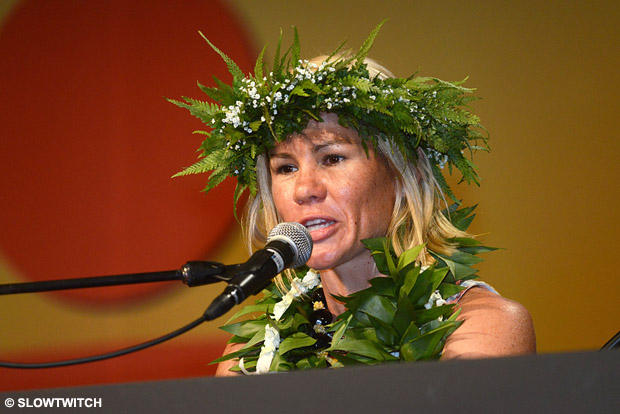
Slowtwitch: How rough was the water? Did that account for the difference from your swim last year [58:50 in 2013, 1:00:14 in 2014]? [This year Carfrae was 19th out of the water, 5:50 behind top women’s swimmer Amanda Stevens] Were there other factors?
Mirinda Carfrae: Reading the results, it seems like the swim was pretty slow across the board and for every age group. Honestly it didn't feel rough at all. I think the currents were a little bit funky out there and caused a slower swim. That being said, during the swim I didn’t feel that fast. You kind of start out the swim and you know? Four or 500 meters into the race you find yourself in a group – I was in a group of six to eight girls and I was kind of sitting comfortably within that group. I tried to move up to increase the pace a couple of times. But I’m not a game changer in the swim. I finally had to go with the flow. I tried to do it a couple of times. Then I thought I’d better conserve my energy. I had an inkling there would be a sizeable gap behind the leaders out of the swim. And six minutes was it. I thought that might be the case.
ST: You were only 1:24 slower than last year but were still 5:50 behind the first swimmer. Last year there were almost a dozen or more fast swimmers who formed a lead pack of about 10 cyclists well into the ride. So did you gave a bit more of a task this time?
Mirinda: Jodie [Swallow] led out and only three girls went with her. They just decided to go for it in the swim. That was the difference more than anything.
ST: On the bike, there were varying reports – not a horrible wind the whole way, just in particular places. Where was the wind challenging and where was it not so bad?
Mirinda: In my experience racing Kona the last six years, the start of the bike there is really no wind and even kind of a tail wind well past the Kona airport. Not until Waikoloa does it start to turn around where you might be feeling head or cross winds. But this year you could feel a slight headwind early on the Queen K. I had a feeling that there might be trouble ahead. Once we got to Waikoloa it really started to blow. But for the pro women, it wasn't super gusty. There were some gusts but it didn’t feel like you felt in danger at all. But it might have picked up later for some of the age groupers .
ST: What angle were the winds coming at you?
Mirinda: Going out on the Queen K it was sort of on the right shoulder. So that was typical all the way up to Hawi. You had a north-northeast wind pretty much all the way to Hawi. And it got stronger the closer you go to Hawi.
ST: How much did it change coming back from Hawi?
Mirinda: Coming down from Hawi. It was a cross wind and a tailwind much of the way down. Then coming to Waikoloa, we actually had a really nice tailwind. But it didn't last that long. I was really enjoying that section. Then it switched. It was coming up from the ocean the last 20 or 30 miles.

ST: Sounds like you were coping well on your own. But this time around you ended up with more of a deficit than last year. You broke 5 hours last time on the bike [4:58:20]. This time you were 5:48 over 5 hours. Which put you 8th, 14:32 back of Daniela Ryf, 12:30 back of Rachel Joyce and 8:44 back of Jodie Swallow. Some experts said that you were a little smaller not quite as strong and more susceptible to adverse wins and conditions on the Queen K. Any truth to that?
Mirinda: There are two different things to consider. I am small, which can help in the wind. There is less frontal area for the wind to catch. But I am not as strong as some of the other women. Also this year I was pretty patient on the bike. Last year I got on the bike and I had a few people around me. From the start of the bike last year I thought: This is too slow. I am going. This year I had Heather Wurtele near me and I thought she would set a good pace. Actually last year I started near Heather Wurtele, but I took off early and didn’t see her and rode the whole way by myself.
ST: Last year you were 7th off the bike, about 8 minutes down.
Mirinda: This year I decided to ride with the group. For the first part – at least up to Hawi – I had some people around me. So I wasn't straining – I was within my comfort zone.
ST: Can you draw any conclusions about your slower bike leg this year?
Mirinda: You can’t compare this year’s bike performance to last year’s bike performance. Until I see my power figures and I can put them up against each other. And see whether I put out as much power this year as I did last year. I certainly felt last year I worked a lot harder on the bike. And this year I dunno. Something told me to just be patient all day and don’t waste any energy. That is how I approached things – at least up to Hawi. Then coming down, I was way up over my comfort zone. I tried to work really pretty yard on the way home – but obviously not taking anything away from my run.
ST: What strategy did your rivals take this year?
Mirinda: I think they had no choice but to push hard and get as much gap as possible. Fortunately for me, I had the luxury of being a little more conservative maybe and just doing what I had to do.
ST: Were you apprehensive about your growing deficit? Did it worry you?
Mirinda: Absolutely. The biggest fear was the fact that I had no idea what the gap was. In the last few years, I had Heather Jackson giving us splits every 20 miles. And Sean had the white board so you knew exactly where you stood and exactly who was ahead of you and all the time gaps. This year, I got my first split at the end of the Queen K [at Kawaihae]. Up to that point, I had no idea what was going on at the front. I knew I was riding in good company with Heather Wurtele and Julia Gajer – these are some of the best women in the world. I figured if I was hanging with them we shouldn’t be losing that much time. But when we got a time gap at the end of the Queen K, we were 9 minutes down. CHUCKLES. That was not ideal. So I tried to push a little harder up to Hawi. Typically the road up to Hawi and back is where I lose the most time.
ST: Do the larger stronger women have physics on their side on the downhill from Hawi?
Mirinda: Yeah, I think coming down the hill the bigger girls can produce a lot more power than I can. They can carry a lot more speed. It makes sense that I would lose a little bit of time on that downhill from Hawi.
ST: Were you disappointed with your ride to that point?
Mirinda: Honestly I couldn’t race the other competitors the way I would have liked. Or the way I did in past years. I mean, you are racing your competitors. But you are also racing yourself and putting out your best effort. I was being more patient than normal at the beginning of the ride. And I found myself more minutes down and having to pick it up a bit.
ST: Seems like a situation you could prepare for? Did you and Siri discuss tactics how to deal with this situation?
Mirinda: A couple of days before the race, I like to go over things like ‘OK, who are the threats in this race?’ Daniela is a real unknown just because she has never raced Kona. While she has had some fantastic results, we have never really seen her run a strong marathon. So we didn’t know what her ability or her potential for running a marathon was going to be. Obviously Rachel Joyce was someone I was looking at. And Caroline [Steffen] is always there. But there are always so many threats.
ST: So you did not focus on any one threat. There were maybe 6 or 7 women you needed to be aware of?
Mirinda: Yeah I guess you could say that.
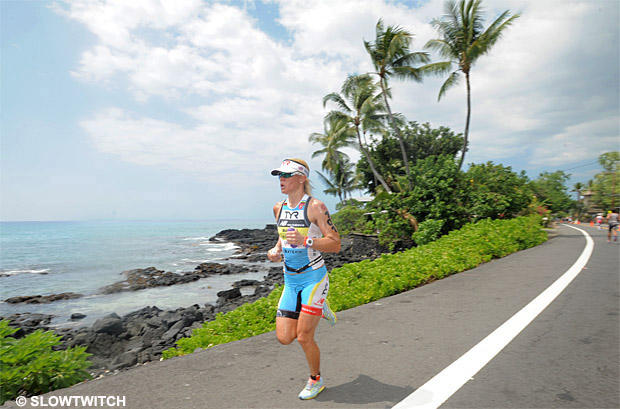
ST: It’s not your business to get inside the heads of your biggest rivals. But it would seem to me, on a day of harder than usual winds, if Ryf, Joyce and Ellis went 4:54, 4:56 and 5:00 that might be the equivalent of 4:48 or 4:50 bike splits on an easier day. Perhaps those efforts stemmed from desperation about your run. Any thoughts?
Mirinda: Yeah. I am not the type of person who tries to get inside my rivals’ heads. My results have done that for me. I knew those girls were motivated to get a gap on me coming off the bike. They were going to play to their strength and the bike is their trump card. Their plan had to be to have a hard bike ride and then hold on in the run. But I have been gifted with the power to run very well off the bike. Especially here in Kona. So I did not think anything about it other than that was what I expected. I knew they would be motivated to ride very fast and put as much distance on myself as possible and roll the dice a little bit. They may have been able to hold on to that lead. Unfortunately they have lost a lot of time on the run while I was still able to hold my usual pace and run through them all.
ST: As a group, they were all off their best form. Joyce ran 3:06:27 – 3 minutes slower than 2013. Ryf never ran Kona but might have been expected to run 5 minute faster than her 3:07:00. Swallow ran 3:08:45 and has a sub-3 hours Ironman marathon in her past. Steffen ran 3:08:43 – 3 minutes faster than her 2013 run but 3 minutes off her 2010 Kona best. As a group they were only able to muster one 3:05 and the rest 3:07 and 3:08 runs. If any of them had been able to run anywhere near their best, you might have had to settle for silver or bronze., Why do you suppose they gave up so much time on the run while you repeated your record-setting pace?
Mirinda: I think I think couple of things happened. They obviously had to lay it out on the bike. So they had to take more risks than they did last year on the bike to gain more time. I am not sure, since I haven't talked to the girls about how they raced. But I think in conditions like that it is very easy to get dehydrated. Because on the bike when conditions are like that it doesn’t feel as hot. I am drawing from my experience in 2012, when you are on the bike it didn’t feel hot. I didn’t hydrate very well that year and I fell apart in the last part of the marathon. I didn’t see the girls this year, so I can only guess. I don't know how they hydrated. But I knew that this year I was very diligent about my nutrition and making sure I got enough water – I’d rather slow down at an aid station and make sure I got everything I needed to stay fueled throughout the race, Much rather lose some seconds getting topped off at aid stations than trying to get an couple of extra seconds here and there.
ST: Basically they were going as hard as they could to the end. Not sure they had much strategy in mind rather than get as big a lead as possible.
Mirinda: At the pre-race press conference, Daniela said she was going to ride the bike very hard. And she did. Rachel Joyce said the same. And Caroline was going to try to go with Rachel. That's how I knew that was the plan going in – and they knew that was the plan going in. Fortunately for me, they weren’t able to hold together on the run as they had in years past.
ST: Did you have a brief communication with Daniela when you passed her?
Mirinda: I just said to her as I ran past, ‘That was a phenomenal performance. Awesome, awesome day!’
ST: What impressed you the most about her race?
Mirinda: I thought Daniela had done a tremendous job. Just about everybody was talking about her before the race. But with Chrissie in 2007, nobody even knew who she was. Chrissie had no pressure – she just went out and raced her race. But when Daniela got to the island, people were saying either I was going to win or they were saying Daniela was. That is a massive amount of pressure to have to deal with your first time coming to the island. So I was just impressed that she just put it all out there. She went out and raced hard from start to finish and pulled it off.
ST: Given conditions, Rachel probably went as well or better than she did last year. She just got bumped back one position, just 1:26 behind Daniela.
Mirinda: Exactly. Rachel is an absolute class act and she is someone who every year comes good for the big race. She puts it all out there and is able to perform well on the big stage every single year. I have a lot of respect for Rachel.
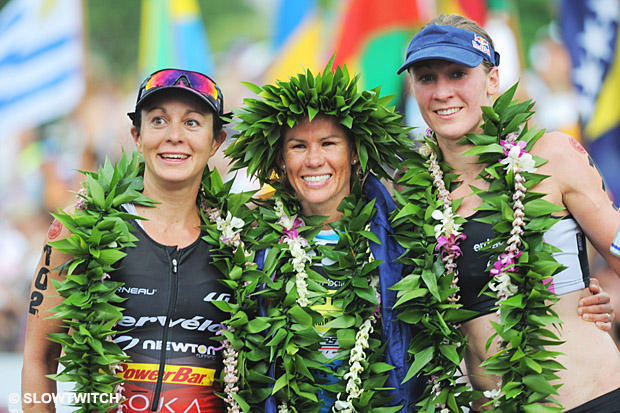
ST: Did you see your husband Tim out on the course?
Mirinda: I did see him actually more times than normal. When I was climbing up to Hawi he was in a good position coming down on the bike. I felt happy he was in such a great place. Again you take a second to think about your partner, and then you have to refocus very quickly on what you are doing.
ST: You need to concentrate coming back from Hawi. A few people were blown off the course.
Mirinda: I heard about that later. I didn't acknowledge him or anything. I just was glad to know where he was and kept going. I saw him next when I was going out on Alii Drive he was coming back and kind of gave me a wave. I sort of waved and he yelled out ‘C’mon you can do it!’ Then I saw him in the Energy Lab. At that stage he had completely fallen apart and the wheels had come off. It is sad to see that happen to someone you love.
ST: What did he say to you?
Mirinda: He was walking out of the Energy Lab as I was going in and he walked across the road to where I was passing. It was like ‘All right. Now you are racing for both of us.’ And ‘You can do this! You can do this. The girls are just ahead.’ It was as if to say, ‘I’m giving you all my energy.’ That is the type of guy he is. He is always emphasizing the positives and forgetting about himself. Trying to give me whatever he can give me. He is inspiring.
ST: What went wrong for him? Obviously he thought he was ready – and so did everyone else.
Mirinda: He is not exactly sure. His stomach locked down. He was OK getting off the bike. He was in a good position. Then, as we all thought, he seemed to be in great shape. He seemed to have everything he needed to be in that front group – for sure. Then his stomach locked down. And once that happens, you are not getting energy and you are not racing any more. Your muscles — forget about it. In an 8 hour race, it is game over. So, right now we are not exactly sure. He said the muscle in his stomach just stopped. Everything felt super tight. It was kind of weird. We will figure it out.
ST: Did you care at all about breaking 9 hours? Looked to me you enjoyed the final chute a bit. Did you just forget about the 55 seconds you were over making this your 4th sub-9 hours at Kona? And the 27 seconds you were away from breaking the 2:50 mark of the marathon?
Mirinda: There were two numbers. I could have broken 9 hours. I was only 55 seconds over 9 hours. And then I was close to breaking the 2:50 barrier on the run. But when I got to the top of Palani with maybe a mile to go, I looked at my watch and thought, ‘Well, Sub 2:50 is within my reach. Do I want to absolutely book it to the finish line? Or do I want to enjoy it?’ Every single year I have come here there was some reason for me to really push for the finish line. I ran pretty hard down Palani. Then I just decided, ‘You know what? I’m just going to enjoy this.’
ST: Was that a change of mind from your original intentions?
Mirinda: At the beginning of that run I wasn’t thinking about winning that race. I was trying to get into the top 5 or top 3 position. After overcoming that big deficit, I found myself winning the race. At that point, I was thinking, ‘A win is enough.’
ST: Why be greedy when you had come so far?
Mirinda: Yes.
ST: And if you were screaming down the steep hill at Palani, you might have tripped and gone head first on the pavement?
Mirinda: Yeah. CHUCKLES.
ST: What were you thinking when you started the run and heard you had a 14:32 deficit? In 1995 Mark Allen and Karen Smyers both overcame 13 minute deficits on the run to win. Did that 14 minutes mean anything to you? Did you say to yourself, ‘Oh, I have to go 35 seconds per mile better?’
Mirinda: No. I try not to do that math. That sounds very daunting. Especially because the girls at the front are all phenomenal athletes. On Rachel’s best day, she can run under 3 hours. We don’t know what Daniela can do on her best day. But then you had Jodie [Swallow] and Mary Beth [Ellis] and Caroline [Steffen] up the front – who are always in great running form. I just had to put my head down and try and think about getting the little things right. Fueling and hydrating and trying not panic basically. The first half of that run, I think if I had panicked I would have paid for it at the end. I tried to keep my head and not think about winning. And not think about how big the deficit was. No matter how well I tried to focus, it was very hard. Every few yards along the path someone would tell me how far I was from the lead. There was plenty of negative talk trying to sink in to my head. I was just trying to put that out of my mind and put together a good run.
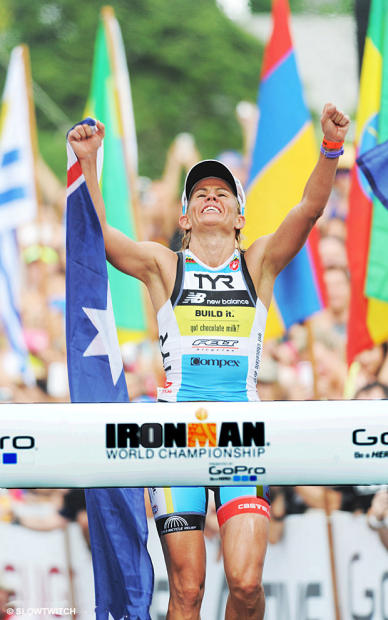
ST: What do you tell that voice inside your head? ‘Shut up!’
Mirinda: You know, the voice is always running in there. I think fortunately for me my body is still able to run at the same pace regardless of what my head is saying. It is easier to still those negative thoughts when you are gaining time and you hear that someone is walking up ahead. I think one of my strengths is that my outside appearance doesn’t change with what is going on in my mind
ST: You are a good poker player?
Mirinda: Yeah, I've become a good poker player, because to a greater or lesser degree I have been in this situation throughout my whole career. I’ve never led from the start. Chasing is not unfamiliar to me. Certainly this is the biggest deficit I have ever come back from. I dunno. I just like to control the controllables and try to fill my mind with questions about my body to find how I am doing. I do it to block those negative thoughts like, ‘Oh, you’re not going to win. You should just pull out. You should drop out.’
ST: If you were a race car driver, you would be looking at the dash board gauges. What are your own body’s gauges telling you?
Mirinda: First of all I am thinking about pacing. You want to go hard but you are looking to find that comfortably uncomfortable place. You are racing hard, so it doesn’t feel great. But you know you can sustain that pace. So you are always trying to figure out if you are going too hard – or not hard enough. Or how much you energy can you squeeze out. Then it’s, ‘OK. How is my stomach handling the nutrition I am taking on? Is it empty?’ Then I am asking myself, ’Am I hydrating at every aid station, trying to keep my your body as cool as possible?’
ST: How do you go about keeping cool? Some top triathletes walk at the aid station when things are getting desperate.
Mirinda: Never walk. But I put water on my head. I drink as much water as I can. You are running through aid stations so you are only getting a couple of gulps. I take everything that is available – cups of water, I put ice down my pants, I put ice down my top. And then I will take coke every second or third aid station as well. But yeah, just try to keep the fluids going. I also take all the gels I carry with me as well. I am taking on as much as I can without upsetting my stomach.
ST: When you are running down Palani amidst the swirling cheers of fans, coaches, family and friends – what are the pinpoints you remember?
Mirinda: I remember the Australians from Team PIS [Penrith Institute of Sport] on Kuakini and Palani. Those guys are always very visible. They are excited to see me. But then I turn on to Alii Drive, that is where I soak up more of the crowd. I saw Bill Riddell, who was my Cannondale Sponsor – my first bike sponsor. He was there the year I first won Kona in 2010. He was standing right in the same spot – he is awesome. He is still a friend of mine. Then I saw my bike sponsor Jim Felt. He was more excited than I have ever seen him before. Those are some of the best moments, moments you remember most when you think back upon the race. You always remember how excited your friends are – the people who have worked hard to get you where you are. Then at the finish line there was [coach] Siri [Lindley]. And Mark [Allen] and Dave [Scott] were there to greet me. I was just kind of in the middle of a blurred swirl of everyone.
ST: So, what does all this mean? Outsiders look at history, times, numbers of wins. But for you Rinny – what does this one mean?
Mirinda: I am still trying to process it. I have a happy feeling when I look at it and go, ‘Whoah! I was able to win on one of the biggest days in triathlon – again!’
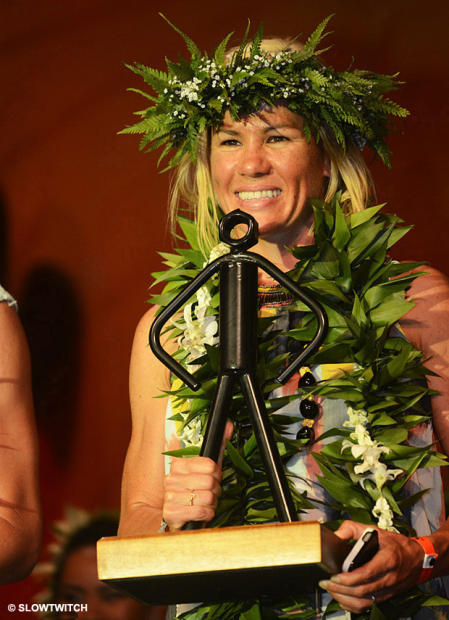
ST: Does you ever get used to it? Does it ever become normal, something expected?
Mirinda: I don't think I go into the race ever thinking about winning. I know I am in good shape. I think this is going to be a tough race and hopefully I can get it right. I am in good shape. But I never expect to win. In fact, I thought Rachel was the favorite this year.
ST: But you were aiming at it?
Mirinda: I dunno. Right now, I am just over the moon – to the third degree. This race has been very good to me. I think I was made to race in Kona.
ST: What have you and Tim said to one another?
Mirinda: He is naturally very excited and very proud of me. Excited that I was able to win. Then we go back and talk about this race. I am thinking, ‘Together we got it half right.’ Now we are figuring out what happened and how we did and how we felt. And then we are planning to ensure whatever happened with Tim during this race doesn't happen again. I mean, we are a team. He helps me get to the start line in the best possible shape and I do whatever I can to help him get there as well. Bottom line, we have to get him a world title. That will be the number one goal next year.


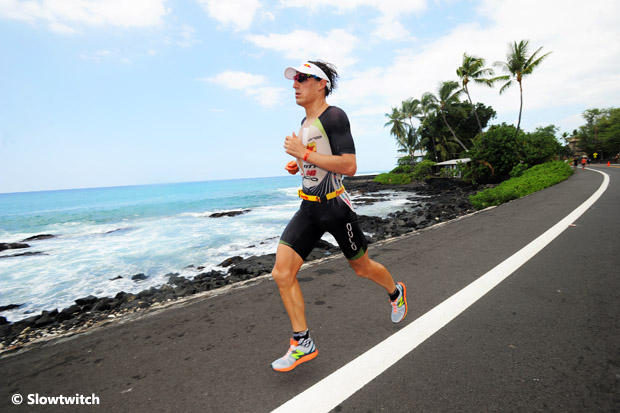
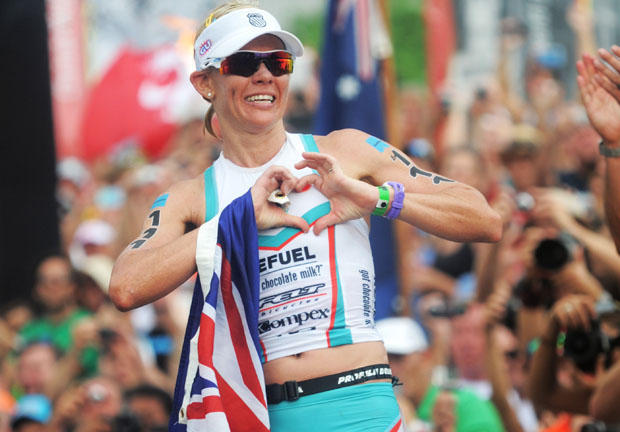
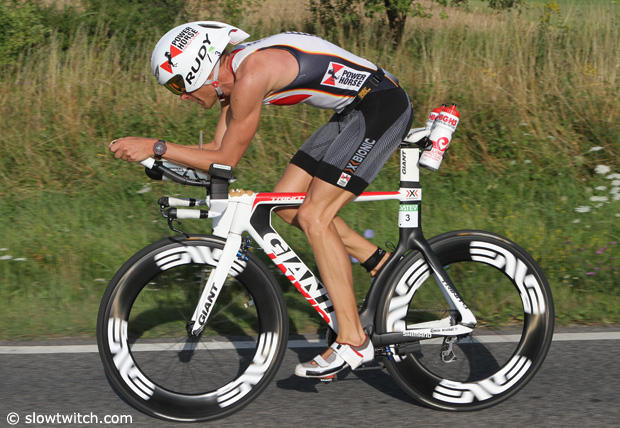

Start the discussion at slowtwitch.northend.network